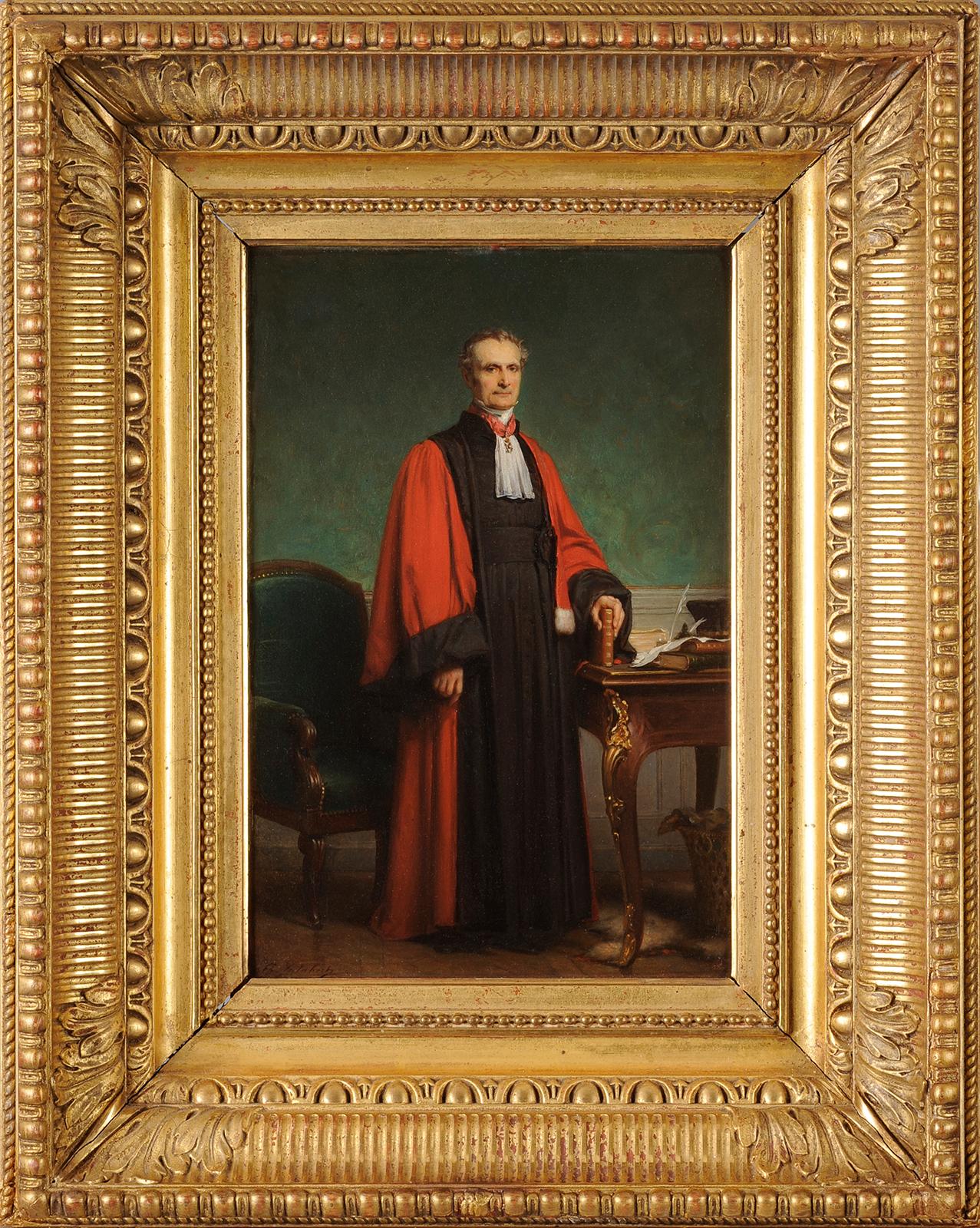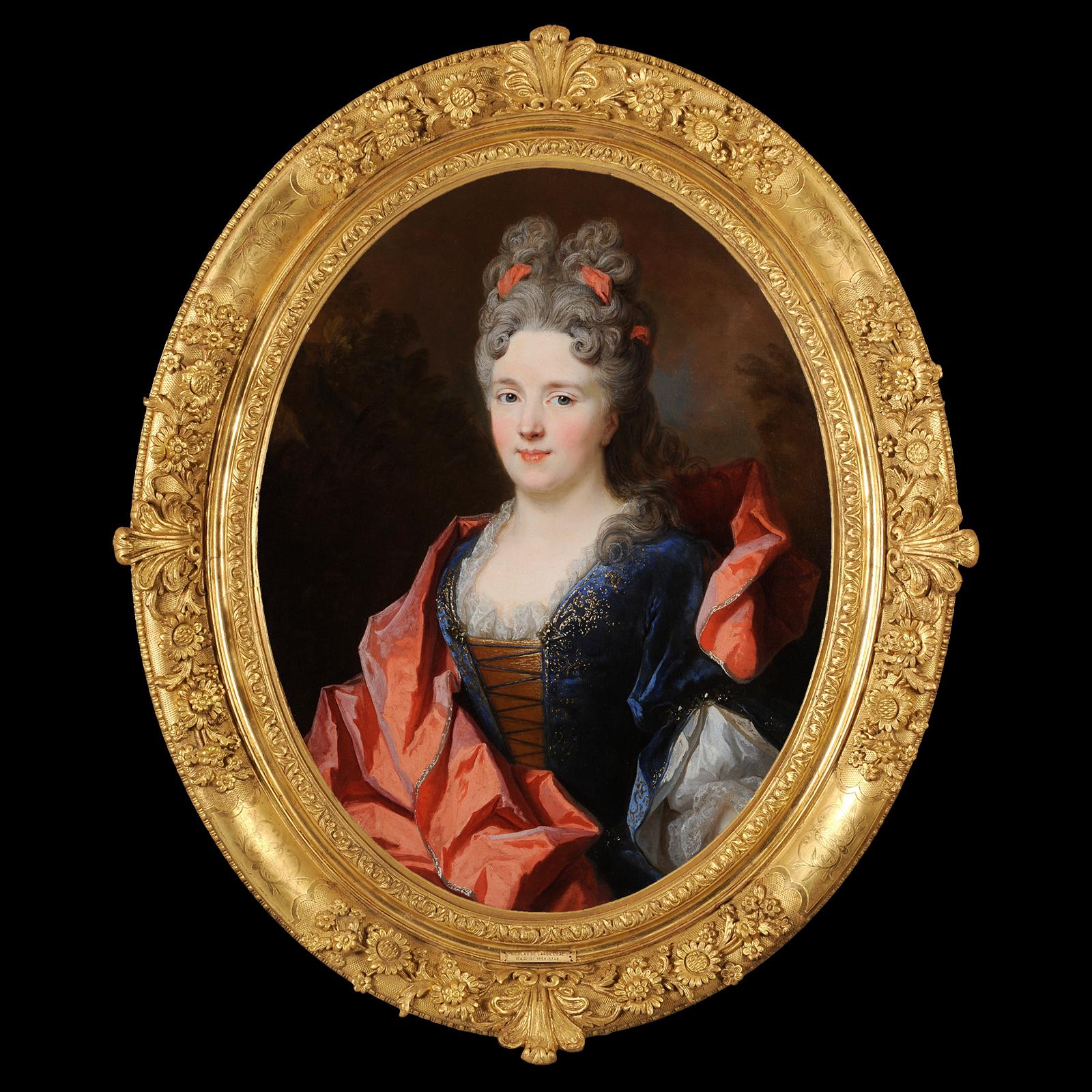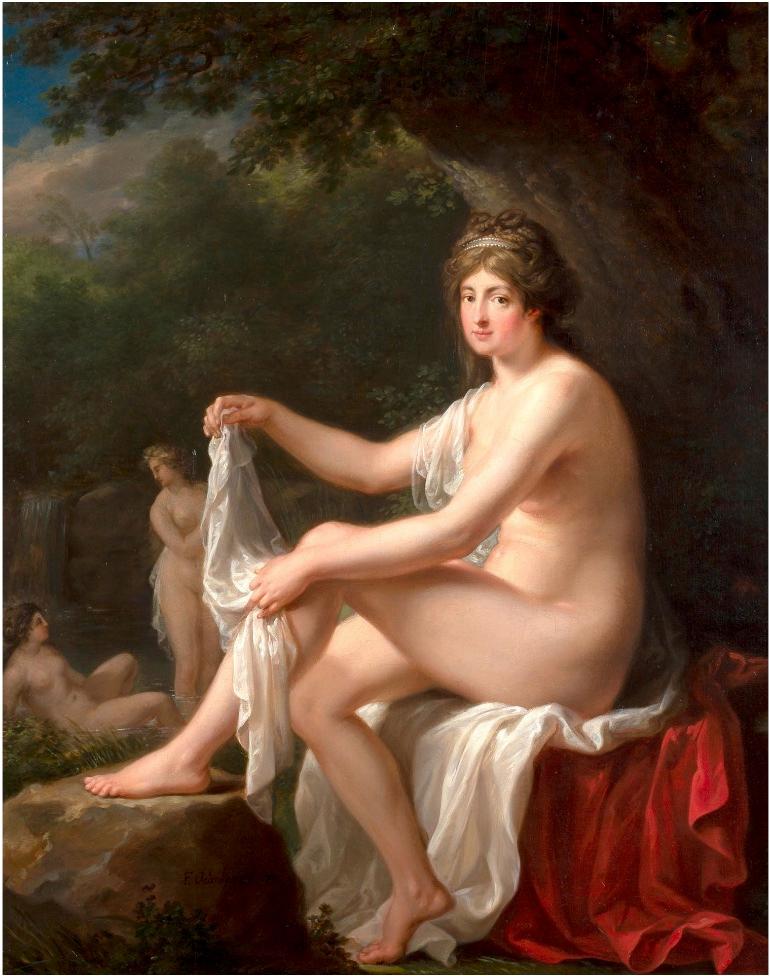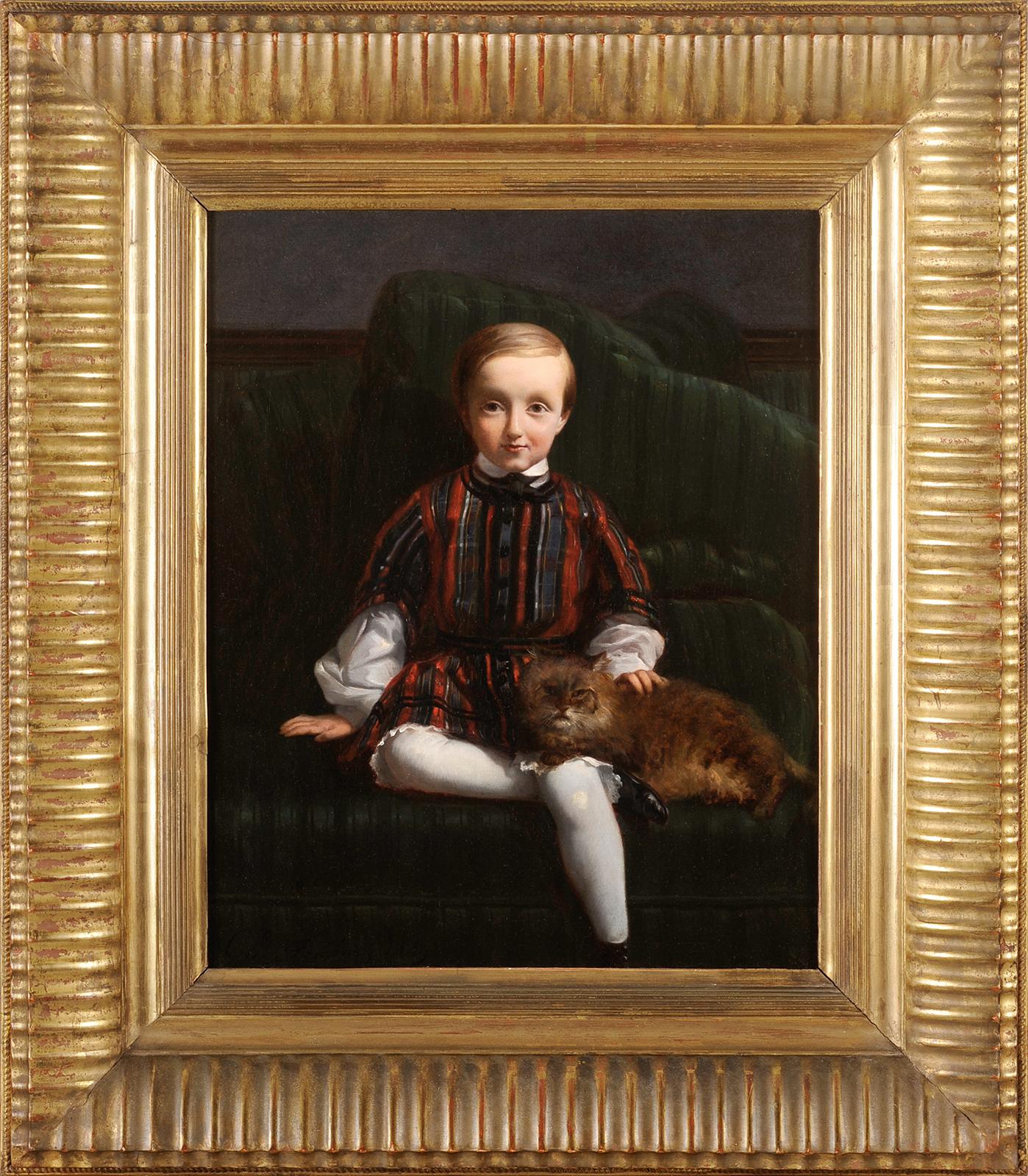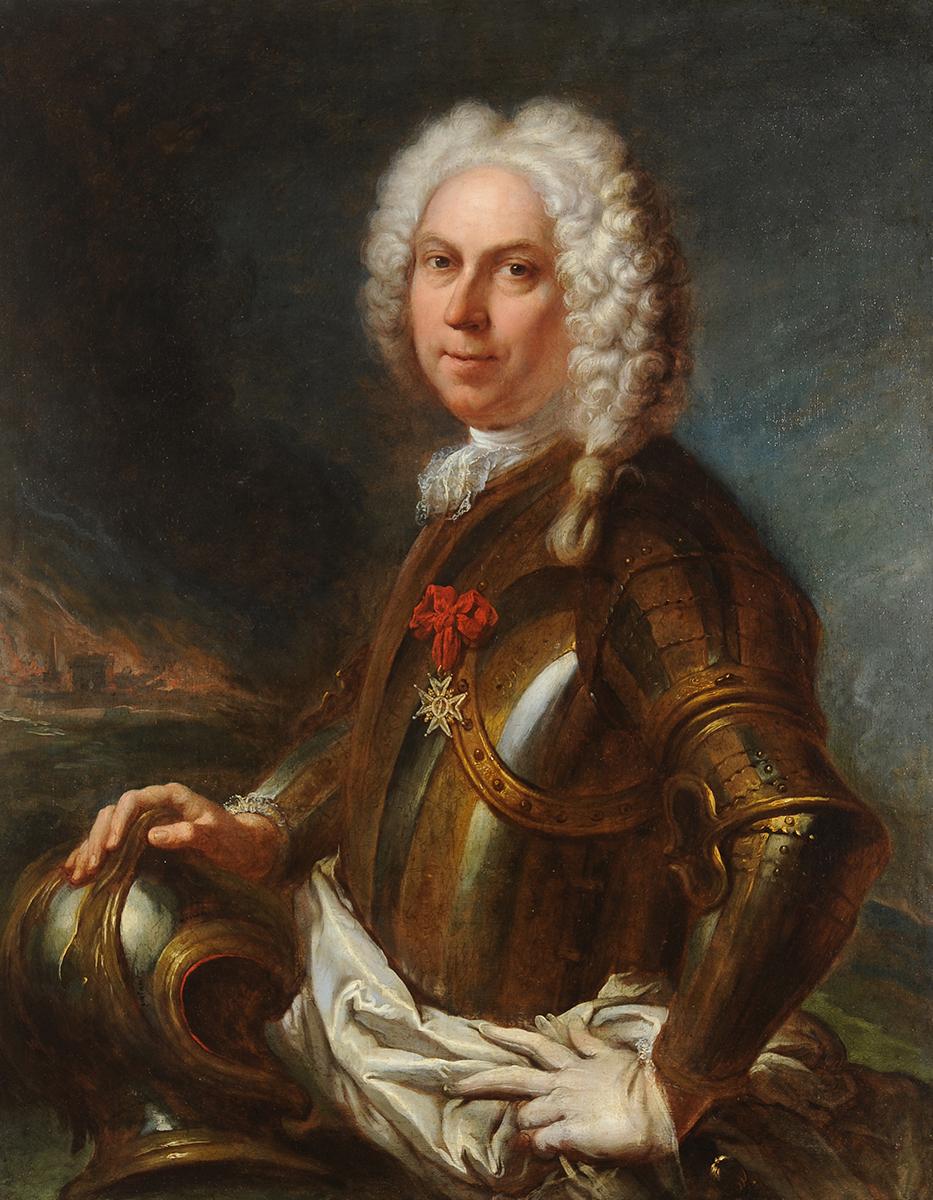Items Similar to Portrait of a Lady . Louis Ferdinand Elle the Younger. ( Paris, 1612-1689), attrib
Video Loading
Want more images or videos?
Request additional images or videos from the seller
1 of 20
Portrait of a Lady . Louis Ferdinand Elle the Younger. ( Paris, 1612-1689), attrib
About the Item
Portrait of a lady .
Louis Ferdinand Elle the Younger. ( Paris, 1612-1689), attributed.
Circa 1680.
Oil on canvas, resting on cardboard.
In 19th-century giltwood frame.
A female portrait recently appeared in our gallery from a private collection, the portrait was at first attributed to the Dutch school.
The assessment of the painting's artistic qualities was complicated by its condition: the painting was hidden under a very thick layer of old varnish.
Subsequent cleaning of the painting revealed a high-class original painting by the author. After complex research, the painting was clearly attributed to the French school, and its dating, due to the characteristics of the costume and hairstyle, began to vary between 1670 and 1690.
A stylistic analysis of the portrait allows us to attribute its authorship to the outstanding French portraitist Louis Ferdinand Elle.
After receiving his early artistic training in the workshop of his father Ferdinand Elle (1570 in Mechelen - 1637 in Paris), Louis Ferdinand began an independent career quite early. Thanks to his father's clients, the artist quickly strengthened his position at court.
Elle's youthful and mature portraits (for example, the portrait of Louis XIV in armor, Metz, Musée de la Cour d'Or) show how great an influence her father's work had on the artist. The artist uses established (but somewhat archaic) portraiture from around 1620, characterized by a somewhat elongated silhouette of the figure, soft modeling of light and shadow, and an extremely generalized interpretation of the face.
The artist remained devoted to this scheme for quite a long time, although the portrait formula in France was undergoing significant changes.
All the more unexpected is the radical change in the style of Elle's portraits in the last years of her life, in the 1680s.
This was related to the arrival in Paris of the greatest portrait painter Louis Ferdinand Voet.
Voet's manner, which Pope Innocent XI called "an instrument of voluptuousness" (which is why Voet was forbidden to work in Rome), proved to be incredibly attuned to the artistic atmosphere in Paris. Elle's style begins to resemble Voet's work: her painting becomes more transparent, incredible freedom in technique appears, and her images are full of sensual charm.
A small portrait of an unknown lady from Alina Malova's gallery collection is an excellent example of Elle's latest work.
The painting technique amazes with its virtuosity; it is free and artistic.
Shape modeling is constructed using several artistic techniques simultaneously.
Using light, the artist determines the volume, but completes the form by using the unfinished effect. Interesting figurative interpretation of the model.
A feature of Elle's entire work has been her very personal and intimate view of the model. The dialogue between the person depicted and the viewer in El's work is based on semi-emotions, a technique inherited from his father's art. This is particularly evident in the female portrait of our gallery.
A slight tilt of the head, a gentle gaze, and a slight half-smile create the charm of the image and seem to anticipate the 18th-century French portrait.
- Attributed to:Louis Elle (Ferdinand) (1612 - 1689)
- Dimensions:Height: 23.23 in (59 cm)Width: 20.08 in (51 cm)Depth: 2.37 in (6 cm)
- Medium:
- Movement & Style:
- Period:1680-1689
- Condition:
- Gallery Location:Firenze, IT
- Reference Number:1stDibs: LU2464213224152
About the Seller
4.7
Platinum Seller
These expertly vetted sellers are 1stDibs' most experienced sellers and are rated highest by our customers.
Established in 2016
1stDibs seller since 2023
30 sales on 1stDibs
Typical response time: 4 hours
- ShippingRetrieving quote...Ships From: Firenze, Italy
- Return PolicyA return for this item may be initiated within 10 days of delivery.
More From This SellerView All
- Girl with glasses. Circa 1920. Double portrait. Spalmach Gino (Rome, 1900-1966)Located in Firenze, ITGirl with glasses. About 1920-30. Double portrait. Spalmach Gino (Rome, 1900 - 1966). Painted on two sides: on one side the young woman with glasses is represented, in charcoal/penci...Category
1920s Art Deco Portrait Paintings
MaterialsOil, Cardboard
- Patrick Boudon. Inner Family. Post-war Expressionism. 1970s.By Patrick BoudonLocated in Firenze, ITPatrick Boudon. Inner Family. Post-war Expressionism. 1970s. Patrick Boudon. Art Informel. Ecole de Paris. Technique: oil on cardboard. This painting by Patrick Boudon from the 197...Category
1970s Expressionist Figurative Paintings
MaterialsOil, Cardboard
- Portrait of an elegant woman in the park at sunset. Circa 1845Located in Firenze, ITPortrait of an elegant woman in the park with a white handkerchief at sunset. Circa 1845. The painting depicts a young woman with a delicate and luminous porcelain-like face, possi...Category
Mid-19th Century Romantic Portrait Paintings
MaterialsOil, Board
- Ca. 1820 Portrait of a Woman with Kashmir shawl.Located in Firenze, ITCa. 1820 Portrait of a Woman. Léon Cogniet (1794-1880, Paris), attributed. French school of 19th century. Tecnicque: oils on canvas. Dimensions: 70cm x 61cm 20th century wooden...Category
1820s Romantic Portrait Paintings
MaterialsOil, Canvas
- Girl with fruit. Market. Year 1958. Signed Sergio Cirno Bissi (1902 - 1987)Located in Firenze, ITGirl with fruit. Market. Year 1958. Signed Sergio Cirno Bissi (Carmignano, 1902 - Florence, 1987). The very colorful and expressive painting is created...Category
1950s Post-Impressionist Portrait Paintings
MaterialsCanvas, Oil
- The Holy Family with saints Anne and Joseph. Tuscan school. Circa 1610.Located in Firenze, ITThe Holy family with St. Joseph and St. Anna. Tuscan school. Late mannerist period, Circa 1610. Oil on canvas. Size 102cm x 77cm Painting by an unknown Tuscan painter from the lat...Category
18th Century and Earlier Renaissance Figurative Paintings
MaterialsCanvas, Oil
You May Also Like
- Portrait of President Louis-Marie de BelleymeBy Charles JalabertLocated in BELEYMAS, FRCharles François JALABERT (Nîmes 1818 - Paris 1901) Portrait of President Louis-Marie de Belleyme (1787-1862) Oil on cardboard H. 25 cm; L. 17 cm Signed lower left - Made around 1856...Category
1850s French School Figurative Paintings
MaterialsOil, Cardboard
- Model undressingLocated in BELEYMAS, FRJulius EXNER (Copenhagen, 1825 - Copenhagen, 1910) Model stripping Oil on canvas H. 122 cm; L. 74 cm Signed and dated 1842 lower right Exhibition: most likely Charlottenborg Salon of 1845, under number 110, titled Modelfigur, awarded with a silver medal Provenance: Emilio Fernando Bolt (c.1860 - 1944), acquired from the artist around 1900, then by descent Our painting was produced as part of the summer sessions organized between 1839 and 1850 by Christoffer Wilhelm Eckersberg (1783-1853), the master of Danish painting of the first half of the 19th century, in his private studio-apartment on the ground floor. floor at the Royal Academy of Fine Arts in Copenhagen. The master brought together a few students there between June and September, rented one or two models for the season, which were painted from different angles, the artists (including Eckersberg himself) sitting side by side. Eckersberg used to paint a fairly small version, the pupils of the larger formats. The work fits more generally into the legendary context of the research and reforms carried out by Eckersberg concerning the studies of nudes and in particular of female nudes, to make this exercise a genre of painting in its own right. Following his two-year stint in Jacques-Louis David's studio in Paris in 1811, Eckersberg had been made aware of work on the nude and in particular on live models, in natural light, while in Denmark the drawings were then only made from casts of antique models or other mannequins. In 1822, when he had been a professor there since 1818, it was he who had the Royal Academy of Copenhagen authorize the study of nudes, no longer in the evening by candlelight, but in natural light; from 1833, it was still he who allowed students to work on nude female models, even if the official authorization of the Academy did not take place until 1839. It was this same year that he instituted his summer sessions, on a private basis, to orient his painting and that of his students towards a new conception of the representation of models: even if the nude remains the real theme, it does not however, this is more than just an academic exercise. The subject is placed in a contemporary interior, with a rather sophisticated decor, and occupied with an intimate activity (it is this type of intimate vein that we will find later in Degas or Cassatt for example); thus in our painting, the young woman is supposed to take off her clothes to wash. The objective is that the viewer forgets that the master and his students are painting a model during a posing session, and that he instead has the impression of being alone with the model, but invisible, almost like a voyeur in spite of himself. Moreover, in these paintings, the model never looks towards the spectator, inducing a psychological distance with him, whereas model and artist are actually physically very close. On the other hand, it is not a question of idealized nudes either, even if Eckersberg, proof of his debt to the antique, chooses fairly classic models and poses. The sensuality is real and very present, with dreamy, even innocent, and timeless expressions (the models do not seem to have a defined age), suave and slow attitudes and movements, and especially with clothes that hide or reveal skillfully parts of the female body: upper buttocks, pronounced hips... Made by an artist under 20, our sensual painting is probably one of the most beautiful and spectacular produced by the students of Eckersberg during these summer sessions. With a perfect balance between the firmness of an ancient statue (it recalls the Venus de Milo) and the softness of the feminine forms, highlighted by a harmonious palette, it captures the attention with many details: the almost photographic folds white clothing...Category
1840s French School Nude Paintings
MaterialsCanvas, Oil
- Presumed portrait of Princess de Conti, Marie-Anne de BourbonBy Nicolas de LargillièreLocated in BELEYMAS, FRNicolas de LARGILLIERRE (Paris 1656 – 1746) Portrait of a woman, presumed to be Marie-Anne de Bourbon, Princess of Conti (1666-1739) Oil on oval canvas H. 80 cm; L. 61 cm (107 x 91 c...Category
1730s French School Figurative Paintings
MaterialsCanvas, Oil
- Diana Bathing 18th Century Oil on Canvas by Friedrich Olenhanz 1765-1839Located in LA BOUILLE, FR"As the incarnate of dawn shines in the morning, such a blushed Diane's complexion exposed without veils to the eyes of a mortal" Les Métamorphoses by Ovide Less tragic is our destin...Category
18th Century French School Paintings
MaterialsCanvas, Oil
- Sketch of a dandy portraitLocated in BELEYMAS, FRFrench school circa 1840 Sketch of a dandy portrait Oil on canvas mounted on cardboard H. 21 cm; L. 20.5 cmCategory
1830s French School Figurative Paintings
MaterialsCanvas, Oil
- Portrait of a man in armorLocated in BELEYMAS, FRAttributed to Jacques DUMONT aka DUMONT LE ROMAIN (Paris 1701 - 1781) Presumed portrait of Louis-Joseph de Formanoir (?-1732) Oil on canvas H. 91.5 cm; ...Category
1750s French School Figurative Paintings
MaterialsCanvas, Oil
Recently Viewed
View AllMore Ways To Browse
Girls On Toilet
Man In White Shirt
Oil Portrait Oval Frame
Dan Alva
W Eddie Painting
Jana Pastel Portrait
Royo Originals
Man Cigar Oil
Daniel Brennan
Earl Leicester
Edward Algernon
Elisabeth Dujarric De La Riviere
Francis Hastings
Hunt Slonem Her Majesty
John Ainsworth
Memento Mori Egyptian
Order Of Lazarus
Ramon Hours
